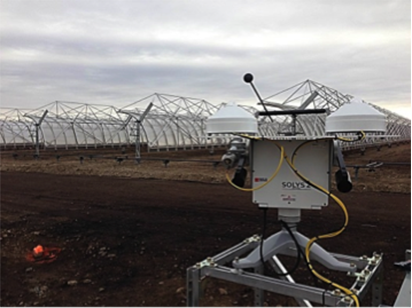


メディシン ハット市 (CMH) は、相当な天然ガス埋蔵量があるため、「ガス シティ」と呼ばれています。しかし数年前、同市は「ハット スマート」と呼ばれる省エネおよび再生可能エネルギー プログラムを開始しました。このプログラムの成果の 1 つが、2014 年 11 月に運用を開始したこの 1 MW CST 実証システムです。これは、集光型太陽熱発電プロジェクトが建設された最北の地です。メディシン ハットは、年間平均日照時間が 2,544 時間、日照日数が 330 日と、カナダで最も日照に恵まれた場所の1 つ です (カナダ環境省) 2。また、メディシン ハットは、直達日射量 (DNI) が 5.1 (メディシン ハット市) と太陽資源も豊富で、CST に適した場所です。
敷地内で利用可能な太陽資源を判定するために、Kipp & Zonen の太陽計測機器を備えた Campbell Scientific 環境モニタリング ステーションが設置されました。このステーションは、全天日射、直達日射、拡散日射、および風速や風向などのその他のパラメータのデータを測定して収集し、風速が強すぎてソーラー アレイを安全に操作できない場合に市に警告します。このステーションは、2 つの CMP22 二次標準日射計と CHP1 日射計を備えた Kipp & Zonen SOLYS 2 太陽追跡装置に基づいています。
Campbell Scientific Canada は、データ サービス部門を通じて、このステーションのデータ収集、ホスティング、品質管理、レポート作成を行っています。データ サービスは、スケジュールされた収集間隔に基づいてセルラー モデム経由でリモートでデータを収集し、そのデータを Campbell Scientific サーバーにアップロードします。データの品質と整合性を確保するために、品質管理が行われます。その後、データは月次レポートにまとめられ、CMH とカナダ天然資源省 (NRCan) の両方がステーションの有効性を判断するのに役立ちます。
NRCan は、太陽光集光実証プロジェクトの期間中、この施設の太陽光計測機器を CMH に貸し出しており、太陽光データ収集において両組織に役立っています。NRCan の Reda Djebbar 博士 (工学) によると、「測定データは CMH が CST の予想パフォーマンスと測定パフォーマンスを比較評価および検証するために使用されます。また、NRCan は Environment Canada と連携して、気象設計入力データ ファイルを生成するために使用される衛星から得られた太陽光資源データを検証し、エンジニアリングおよび科学コミュニティが HVAC ビル アプリケーションや太陽光発電システム設計などの幅広いアプリケーションに使用できるようにします。」
文献
1 - メディシン ハット市。「アルバータ州が技術の未来を革新」2011 年 10 月 31 日。集光型太陽熱エネルギー ワークショップ。2015 年 2 月 4 日 <http://www.albertechfutures.ca/Portals/0/RDServices/CST%20Tech%20Workshop/9%20-%20MacKenzie%20MedHat%20Project.pdf>。
2 - カナダ環境省。「カナダの気候標準 1981 - 2010 観測所データ」2015 年 1 月 12 日。カナダ政府。2014 年 2 月 4 日 <http://climate.weather.gc.ca/climate_normals/results_1981_2010_e.html?stnID=2273&lang=e&StationName=Medicine+Hat&SearchType=Contains&stnNameSubmit=go&dCode=1&dispBack=1>
ケーススタディの概要
アプリケーション
太陽資源モニタリング場所
カナダ、アルバータ州メディシンハット市使用製品
31461 CHP1-L寄稿者
Collin Quarrie, CSC Renewable Energy Measurement Consultant参加団体
メディシンハット市、カナダ天然資源省計測項目
全天日射量、直達日射量、拡散日射量、風速、風向参加コンサルタント/インテグレーター
Juniper Systems, Inc.PDFで見る